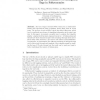Free Online Productivity Tools
i2Speak
i2Symbol
i2OCR
iTex2Img
iWeb2Print
iWeb2Shot
i2Type
iPdf2Split
iPdf2Merge
i2Bopomofo
i2Arabic
i2Style
i2Image
i2PDF
iLatex2Rtf
Sci2ools
69
Voted
SEMWEB
2007
Springer
2007
Springer
Understanding the Semantics of Ambiguous Tags in Folksonomies
The use of tags to describe Web resources in a collaborative manner has experienced rising popularity among Web users in recent years. The product of such activity is given the name folksonomy, which can be considered as a scheme of organizing information in the users’ own way. In this paper, we present a possible way to analyze the tripartite graphs – graphs involving users, tags and resources – of folksonomies and discuss how these elements acquire their meanings through their associations with other elements, a process we call mutual contextualization. In particular, we demonstrate how different meanings of ambiguous tags can be discovered through such analysis of the tripartite graph by studying the tag sf. We also discuss how the result can be used as a basis to better understand the nature of folksonomies.
Related Content
| Added | 09 Jun 2010 |
| Updated | 09 Jun 2010 |
| Type | Conference |
| Year | 2007 |
| Where | SEMWEB |
| Authors | Ching-man Au Yeung, Nicholas Gibbins, Nigel Shadbolt |
Comments (0)

